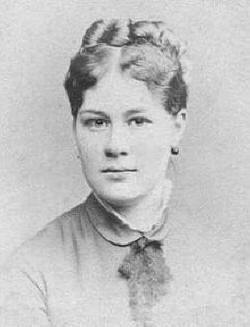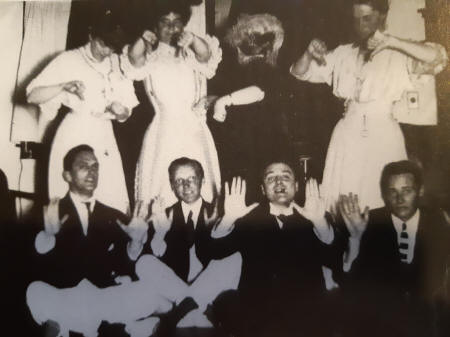

Queer Places:
Académie Julian, Passage des Panoramas, Paris, France
Académie Colarossi, 10 Rue de la Grande Chaumière, 75006 Paris, France
Pennsylvania Academy of the Fine Arts (PAFA), 118-128 N Broad St, Philadelphia, PA 19102
83 Eastern Point Blvd, Gloucester, MA 01930
West Laurel Hill Cemetery, 225 Belmont Ave, Bala Cynwyd, PA 19004
 Cecilia Beaux (May 1, 1855 – September 17, 1942) was an American society
portraitist, in the manner of
John Singer
Sargent. She was a near-contemporary of American artist Mary Cassatt and
also received her training in Philadelphia and France. Her sympathetic
renderings of the American ruling class made her one of the most successful
portrait painters of her era.
Cecilia Beaux (May 1, 1855 – September 17, 1942) was an American society
portraitist, in the manner of
John Singer
Sargent. She was a near-contemporary of American artist Mary Cassatt and
also received her training in Philadelphia and France. Her sympathetic
renderings of the American ruling class made her one of the most successful
portrait painters of her era.
In 1903 Isabella Stewart Gardner was introduced to Abram Piatt Andrew, Jr, by Cecilia Beaux, one of the most popular American painters of the era. Beaux was a native of Philadelphia, where she studied art in addition to taking classes in Paris. Beaux had been the first of a group of lesbians and gay men to move to Eastern Point in Gloucester. Her next door neighbor was Joanna Stewart Davidge, the head of a New York School for girls. The next house down belonged to Andrew. Gardner and Andrew became instant friends and she started spending time in Gloucester. Andrew had been recently appointed a Harvard professor, one of the youngest of his time, and had just moved into his Gloucester mansion, Red Roof, a house "honeycombed with secret rooms, hidden passages, bedchamber peepholes and unexpected mirrors." Gardner had invited John Singer Sargent to paint at Fenway Court and Sargent was presnet for Andrew's first visit. Though the two became friends and Sargent would visit Red Roof, Andrew was not impressed by Sargent's physical appearance. "He is very business-like, unaesthetic-looking-person, very large and burly, and with a florid face." Andrew had met Beaux because he was a friend of her nephew, who had also been included in the luncheon at Fenway Court that ended up lasting for hours, an extravagance that Gardner rarely granted.
Eastern Point was an enclave occupied by a somewhat louche group of "Bohemian" artists and intellectuals with frequent visits from some of the more colorful and unconventional members of Boston Society, in particular Isabella Stewart Gardner, the legendary art collector and builder of Fenway Court in the Back Bay Fens, now the Isabella Stewart Gardner Museum. Eventually Davidge, Andrew, Beaux, and Sleeper called their collection of summer houses on Eastern Point Dabsville, DABS containing the initials of the core members.[2]
By 1906, Beaux began to live year-round at Green Alley, in a comfortable colony of "cottages" belonging to her wealthy friends and neighbors. All three aunts had died and she needed an emotional break from Philadelphia and New York. She managed to find new subjects for portraiture, working in the mornings and enjoying a leisurely life the rest of the time. She carefully regulated her energy and her activities to maintain a productive output, and considered that a key to her success. On why so few women succeeded in art as she did, she stated, "Strength is the stumbling block. They (women) are sometimes unable to stand the hard work of it day in and day out. They become tired and cannot reenergize themselves."[52]
Cecilia Beaux spent summers at her Gloucester home, Green Alley, where she enjoyed hosting evening gatherings of her neighbors. She never married. "Faithful in attendance were Harry Sleeper and Piatt Andrew, whose brilliancy of repartee has never been excelled, according to one observer.
While Beaux stuck to her portraits of the elite, American art was advancing into urban and social subject matter, led by artists such as Robert Henri who espoused a totally different aesthetic, "Work with great speed..Have your energies alert, up and active. Do it all in one sitting if you can. In one minute if you can. There is no use delaying…Stop studying water pitchers and bananas and paint everyday life." He advised his students, among them Edward Hopper and Rockwell Kent, to live with the common man and paint the common man, in total opposition to Cecilia Beaux's artistic methods and subjects.[53] The clash of Henri and William Merritt Chase (representing Beaux and the traditional art establishment) resulted in 1907 in the independent exhibition by the urban realists known as "The Eight" or the Ashcan School. Beaux and her art friends defended the old order, and many thought (and hoped) the new movement to be a passing fad, but it turned out to be a revolutionary turn in American art.

Cecilia Beaux (top right), A. Piatt Andrew (lower left) and Henry Davis
Sleeper (second from left)
In 1910, her beloved Uncle Willie died. Though devastated by the loss, at fifty-five years of age, Beaux remained highly productive. In the next five years she painted almost 25 percent of her lifetime output and received a steady stream of honors.[54] She had a major exhibition of 35 paintings at the Corcoran Gallery of Art in Washington, D.C., in 1912. Despite her continuing production and accolades, however, Beaux was working against the current of tastes and trends in art. The famed "Armory Show" of 1913 in New York City was a landmark presentation of 1,200 paintings showcasing Modernism. Beaux believed that the public, initially of mixed opinion about the "new" art, would ultimately reject it and return its favor to the Pre-Impressionists.
Beaux was crippled after breaking her hip while walking in Paris in 1924. With her health impaired, her work output dwindled for the remainder of her life.[33] That same year Beaux was asked to produce a self-portrait for the Medici collection in the Uffizi Gallery in Florence.[55] In 1930 she published an autobiography, Background with Figures.[33] Her later life was filled with honors. In 1930 she was elected a member of the National Institute of Arts and Letters; in 1933 came membership in the American Academy of Arts and Letters, which two years later organized the first major retrospective of her work. Also in 1933 Eleanor Roosevelt honored Beaux as "the American woman who had made the greatest contribution to the culture of the world".[56] In 1942 The National Institute of Arts and Letters awarded her a gold medal for lifetime achievement.
Cecilia Beaux died at the age of 87 on September 17, 1942, in Gloucester, Massachusetts.[1] She was buried in Bala Cynwyd, Pennsylvania. In her will she devised that a Duncan Phyfe rosewood secretaire made for her father go to her cherished nephew Cecil Kent Drinker, a Harvard physician, whom she had painted as a young boy.[57][58]
My published books: